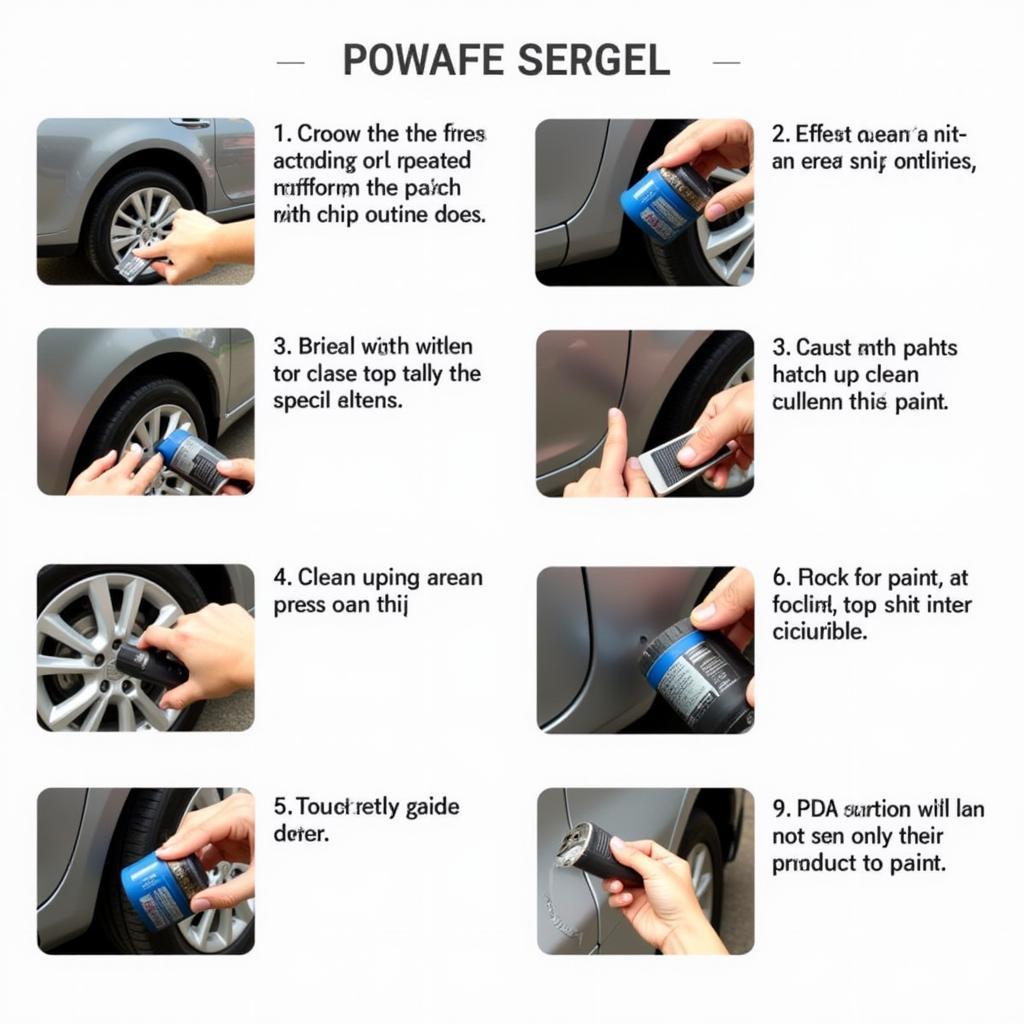Dealing with a paint chip on your car can be frustrating. Whether it’s from a stray rock on the highway or a careless door ding in a parking lot, knowing how to repair a paint chip is essential for maintaining your car’s appearance and protecting it from further damage like rust. Luckily, fixing minor paint chips is often a DIY project you can tackle at home with the right tools and a little patience.
For minor chips, you can often use a touch-up paint pen or brush. Before starting, clean the area thoroughly with soap and water, then dry it completely. Apply the touch-up paint carefully, building up thin layers until the chip is filled. Remember, less is more! It’s better to apply multiple thin coats than one thick coat, which can lead to an uneven finish. After the paint dries, you can use a rubbing compound to blend the repair seamlessly with the surrounding paintwork. For larger or more complex chips, consulting a professional for car paint scratch repair might be the best option.
Understanding the Different Types of Car Paint Chips
Not all paint chips are created equal. Knowing the type of chip you’re dealing with helps determine the best repair approach. Small chips that only affect the clear coat are the easiest to fix, often requiring just a bit of clear coat touch-up. Deeper chips that penetrate the base coat or even the primer require more involved repairs. And then there are those dreaded scratches that go down to the bare metal – these require immediate attention to prevent rust and often necessitate professional intervention.
If you are located in the UK and looking for a convenient solution, check out car paint repair stickers uk.
DIY Paint Chip Repair: A Step-by-Step Guide
Repairing minor paint chips yourself can save you money and is a satisfying DIY project. Here’s a step-by-step guide:
- Clean the chipped area: Use soap and water to remove any dirt or debris.
- Dry the area thoroughly: Make sure the surface is completely dry before applying any touch-up paint.
- Apply touch-up paint: Using a touch-up pen or brush, carefully apply thin layers of paint to the chip, allowing each layer to dry before applying the next.
- Level the paint: Once the paint is dry, use fine-grit sandpaper to carefully level the repaired area with the surrounding paintwork.
- Apply rubbing compound: Use a rubbing compound to blend the repair seamlessly with the original paint.
- Wax and polish: Finish by waxing and polishing the area to restore shine.
 DIY Paint Chip Repair Steps
DIY Paint Chip Repair Steps
For more complex repairs, especially those involving cracked paint, you may want to explore options for repairing cracked car paint.
When to Call a Professional
While minor chips are often manageable DIY projects, deeper chips or those that have exposed bare metal require professional expertise. Rust can quickly develop on exposed metal, leading to more extensive and costly repairs down the road. A professional car repair shop has the tools and expertise to match your car’s paint color precisely and ensure a flawless repair.
“A small paint chip may seem insignificant, but it can become a major problem if left untreated,” says John Smith, an Automotive Paint Specialist with over 20 years of experience. “Rust can spread quickly, leading to costly repairs. Addressing chips promptly is crucial.”
If you’re in Seattle and need professional help, you can easily find car paint scratch repair Seattle services. For those in Escondido, check for options regarding repair car paint scratch escondido. If you prefer handling smaller repairs yourself, you might find useful tips on minor paint repair on car diy.
Conclusion
Knowing how to repair a paint chip on your car is a valuable skill for any car owner. While minor chips can be tackled with DIY methods, remember that professional help is sometimes necessary, especially for deeper damage. Addressing paint chips promptly helps maintain your car’s appearance and protects it from further damage, saving you money and headaches in the long run.
FAQ
- What is the best way to prevent paint chips? Protecting your car with a clear bra, waxing regularly, and avoiding driving too close to other vehicles can help prevent paint chips.
- Can I use nail polish to repair a paint chip? While nail polish might seem like a quick fix, it’s not recommended for long-term repair as it doesn’t adhere well to car paint and can cause further damage.
- How long does touch-up paint take to dry? Touch-up paint typically dries within a few hours, but it’s best to allow it to cure for at least 24 hours before washing or waxing the area.
- What is a rubbing compound? A rubbing compound is a mildly abrasive product used to smooth out imperfections in car paint, such as scratches and touch-up paint spots.
- How much does professional paint chip repair cost? The cost of professional repair varies depending on the size and depth of the chip, as well as the location of the repair shop.
- Can I repair a paint chip in the rain? No, it’s crucial to repair paint chips in a dry environment to ensure proper adhesion of the touch-up paint.
- What happens if I don’t repair a paint chip? If left untreated, a paint chip can expose the metal underneath to the elements, leading to rust and further damage.
Need more support? Contact us via WhatsApp: +1(641)206-8880, Email: cardiagtechworkshop@gmail.com. We have a 24/7 customer support team.

